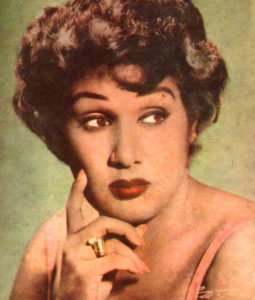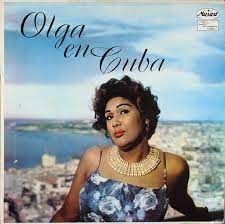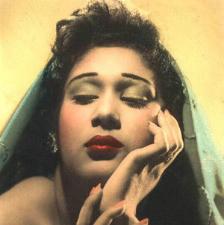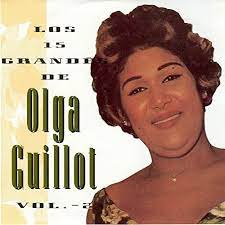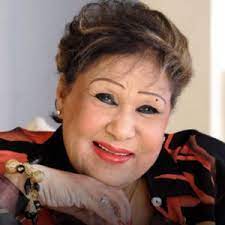OLGA GUILLOT, CANTANTE Y HOY “LA GRAN AUSENTE EN EL CORAZÓN DE CUBA”. VIDEOS
Sus discos dejaron de tocarse públicamente en Cuba a inicios de 1961, el mismo día en que se marchó para no regresar mientras el Castrismo estuviese en el poder. Pero la gente siguió escuchándola.
En los años sesenta popularizó por toda América Latina boleros de Manzanero que tenían resuello de balada. Muchos de sus paisanos, músicos, cantantes y “público en general” se aprendieron ‘Adoro’, ‘Parece que fue ayer’, ‘No, Todavía’ y otros, a través de sus versiones, que nunca, hasta la fecha, ha transmitido la radio cubana. También ‘Qué sabes tú’, de Myrta Silva y muchas “cosas” por entonces nuevas de Luis Demetrio, Lolita de la Colina, Paco Chanona, Chico Novarro y Roberto Cantoral, autor de ‘Soy lo prohibido’, que al parecer a ella le gustaba mucho.
Nadie sabía muy bien quién traía a Cuba sus discos en los años sesenta y setenta (se hablaba de unos brumosos marineros mercantes), pero lo cierto es que aquellos long playings llegaban y pasaban de casa en casa, de mano en mano, o de oído en oído. No era algo nuevo, pues casi desde el mismo momento en que comenzó a grabar, la gente se aprendía las canciones por sus discos, y lo sigue haciendo.
Posiblemente sea la cantante cubana con discografía, y sin lugar a dudas, una intérprete que influyó de en el estilo de muchas otras que aparecieron después. Tuvo también imitadoras patéticas.
VOCALISTA CONCENTRADA EN LO SENTIMENTAL.
A mediados de los años cincuenta muchos compositores la consideraban “un cheque al portador”, porque casi todo cuanto interpretaba lo convertía en éxito. Atrás quedaban los números movidos que cantaba antes: se había convertido en una vocalista concentrada en lo sentimental, con un estilo dramático que apoyaba su timbre, más bien oscuro –alguien lo llamó “raspado”, sin ánimo de agravio–, un amplio registro y un histriónico desempeño escénico.
Vestía lujosos trajes de noche y se adornaba con joyas auténticas. Iniciaba sus actuaciones con un bolero de Orlando de la Rosa que posee letra de despedida: “Me voy con mi canción para olvidarte / me voy, porque yo sé que es lo mejor”. También de este compositor grabó No vale la pena y Qué emoción.
 OLGA GUILLOT CANTA “HE PERDIDO UNA PERLA.
OLGA GUILLOT CANTA “HE PERDIDO UNA PERLA.
En aquellos dias se convirtió en la gran intérprete de René Touzet (‘Estuve pensando’, ‘Anoche aprendí’, ‘La noche de anoche’, ‘Me contaron de ti’); Juan Bruno Tarraza (‘La novia de todos’, ‘Por eso estoy así’, ‘Tú me niegas’, ‘Qué poco me conoces’); Felo Bergaza (‘Miedo’, ‘Si tú me lo dijeras’, ‘Infeliz’); Bobby Collazo (‘Tan lejos y sin embargo te quiero’, ‘Raro hechizo’, ‘Me estoy enamorando’) y de otros autores que comenzaron a darse a conocer en los primeros años de la década de 1940 y componían desde el piano, como Isolina Carrillo, Adolfo Guzmán, Julio Gutiérrez y Candito Ruíz de quien popularizó Vete.
SU SALIDA DE CUBA
Cuando salió de Cuba en marzo de 1961 rumbo a Caracas, Venezuela, era la figura principal del show Serenata Mulata, del cabaret del hotel Capri. La sustituyó Celeste Mendoza y luego Gina León.
El maestro Sabre Marroquín la invitó meses después a trabajar en México. Allí hizo grabaciones para la firma Musart con orquestas dirigidas por Cuco Valtierra, Juan Bruno Tarraza y Jorge Ortega. Son los días de Poquita fé (Bobby Capó), Escándalo (Rubén Fuentes) y Cualquier pretexto (Vicente Garrido). Progresivamente, su estilo interpretativo se tornó más agresivo y el tempo de los arreglos más vivaz y rítmico.
Publicó un excelente disco con composiciones de María Greever con la orquesta de Sabre Marroquín y popularizó, entre muchos otros, Seguiré mi viaje, de Alvaro Carrillo, y Remate, de Rubén Fuentes. En 1963, la Academia de Artes John F. Kennedy, de Hollywood, le otorgó el premio Golden Palm como la Mejor Bolerista de América Latina.
El 31 de octubre de 1964 realizó su primer concierto en el Carnegie Hall, de Nueva York, escenario al que regresó un par de veces más. Actuó en el Teatro Paramount, de Broadway, y brindó también recitales en el Teatro Olympia de París. Se presentó con éxito durante décadas en varias capitales latinoamericanas, en Madrid, y en Barcelona.
Se sucedieron grabaciones, actuaciones, homenajes a lo largo de todos estos años. Vive entonces entre México y Miami. Aparece en cualquier ciudad que se celebre un acto contra el Castrismo: “No volveré mientras ellos estén ahí”. Y canta El son se fue de Cuba, y Nostalgia habanera entre bolero nuevo y bolero antañón. En 1988 celebró su medio siglo de carrera con una gira por varios países, entre ellos, Israel.
Cuando grabó con Los Sabandeños ‘Vete de mí’, de Virgilio y Homero Expósito, y ‘Escándalo’, de Rubén Fuentes, rehúsa aparecer en el disco al enterarse que Silvio Rodríguez es otro de los invitados: “O él o yo”. La solución fue salomónica: se hicieron dos ediciones diferentes.
Una firma mexicana publicó en 1996 un cd doble, Las reinas de Cuba: Olga Guillot y Elena Burke, con grabaciones suyas, en vivo, y de la Burke, en estudio. En 2001 apareció Faltaba yo, con canciones de Manzanero, Meme Solís, Frank Domínguez, Mario Clavell, Juan Bruno Tarraza, entre otros. Estremece su Alma adentro, de la boricua Silvia Rexach. La llamaron La Reina del Bolero, La Madre del Bolero… pero basta con mencionar sólo su nombre para nombrar a una de las principales intérpretes de lo sentimental.
El 12 de julio de 2010, murió de un infarto a la edad de 87 años en la ciudad de Miami Beach. Le sobreviven una hija, Olga Maria Touzet-Guillot, nacida de su relación con el pianista y compositor, René Touzet.
Olga Guillot siempre será nuestra gran ausente en el corazón de la Cuba que no volvió a ver.
OLGA GUILLOT, SINGER AND TODAY THE GREAT ABSENT IN THE HEART OF CUBA. VIDEOS
His records stopped being played publicly in Cuba at the beginning of 1961, the same day he left, never to return while Castroism was in power. But people kept listening to her.
In the 1960s, she popularized Manzanero boleros throughout Latin America that had the breath of a ballad. Many of his countrymen, musicians, singers, and the “general public” learned ‘I adore’, ‘It seems that it was yesterday, ‘No, Yet’ and others, through their versions, which he has never, to date, transmitted Cuban radio. Also ‘What do you know, by Myrta Silva and many “things” at that time new by Luis Demetrio, Lolita de la Colina, Paco Chanona, Chico Novarro, and Roberto Cantoral, author of ‘Soy lo prohibited’, which she apparently liked a lot.
Nobody knew very well who brought their records to Cuba in the sixties and seventies (they spoke of some foggy merchant sailors), but the truth is that those long plays came and went from house to house, hand to hand, or by ear. in-ear. It was not something new, because almost from the moment she started recording, people learned the songs from her records, and she continues to do so.
She is possibly the Cuban singer with a discography, and without a doubt, an interpreter who influenced the style of many others that appeared after her. She also had pathetic copycats.
THE VOCALIST CONCENTRATED ON THE SENTIMENTAL.
In the mid-fifties, many composers considered it “a check to the bearer”, because almost everything she interpreted from it made it a success. Gone were the moved numbers that she sang before: she had become a vocalist focused on the sentimental, with a dramatic style that supported her tone, rather dark – someone called it “scraping”, without wanting to hurt – a wide range and a histrionic stage performance.
She wore luxurious evening gowns and adorned herself with authentic jewelry. She started her performances with a bolero by Orlando de la Rosa that has farewell lyrics: “I’m going with my song to forget you / I’m going, because I know it’s the best.” Also from this composer, she recorded ‘No vale la Pena’ and ‘What an emotion’.
In those days she became the great interpreter of René Touzet (‘I was thinking, ‘Last night I learned’, ‘Last night’, ‘They told me about you’); Juan Bruno Tarraza (‘Everyone’s girlfriend’, ‘That’s why I’m like this, ‘You deny me’, ‘How little you know me); Felo Bergaza (‘Fear’, ‘If you told me, ‘Unhappy’); Bobby Collazo (‘So far and yet I love you, ‘Rare spell’, ‘I’m falling in love) and other authors who began to make themselves known in the early years of the 1940s and composed from the piano, such as Isolina Carrillo, Adolfo Guzmán, Julio Gutiérrez, and Candito Ruíz, who popularized Vete.
HER DEPARTURE FROM CUBA
When she left Cuba in March 1961 for Caracas, Venezuela, she was the main figure in the show Serenata Mulata, from the Capri hotel cabaret. She was replaced by Celeste Mendoza and then Gina León.
The teacher Saber Marroquín invited her months later to work in Mexico. There she made recordings for the Musart firm with orchestras directed by Cuco Valtierra, Juan Bruno Tarraza, and Jorge Ortega. These are the days of Poquita Fé (Bobby Capó), Escándalo (Rubén Fuentes) and Any Pretext (Vicente Garrido). Progressively, her playing style became more aggressive and the tempo of the arrangements more lively and rhythmic.
She published an excellent album with compositions by María Greever with the Saber Marroquín orchestra and popularized, among many others, I will continue my journey, by Alvaro Carrillo, and Remate, by Rubén Fuentes. In 1963, the John F. Kennedy Academy of the Arts, Hollywood, awarded her the Golden Palm Award for Best Bolerista in Latin America.
On October 31, 1964, she performed her first concert at Carnegie Hall, New York, where she returned a few more times. She performed at the Paramount Theater on Broadway, and also gave recitals at the Olympia Theater in Paris. She performed successfully for decades in various Latin American capitals, in Madrid, and in Barcelona.
Recordings, performances, tributes followed one another throughout all these years. She then lives between Mexico and Miami. She appears in any city where an act against Castroism is held: “I will not return while they are there.” And she sings El son se fue de Cuba, and Nostalgia habanera between a new bolero and an old bolero. In 1988 she celebrated the half-century of her career with a tour of several countries, including Israel.
When she recorded with Los Sabandeños ‘Vete de me’, by Virgilio and Homero Expósito, and ‘Escándalo’, by Rubén Fuentes, she refused to appear on the album when she found out that Silvio Rodríguez is another of the guests: “O he or I” . The solution was Solomonic: two different editions were made.
In 1996 a Mexican firm published a double CD, Las reinas de Cuba: Olga Guillot and Elena Burke, with recordings of them, live, and of Burke, in the studio. In 2001, Missing me appeared, with songs by Manzanero, Meme Solís, Frank Domínguez, Mario Clavell, Juan Bruno Tarraza, among others. Shake your soul inside, by the Puerto Rican Silvia Rexach. They called her La Reina del Bolero, La Madre del Bolero … but it is enough to mention only her name to name one of the main interpreters of the sentimental.
On July 12, 2010, she died of a heart attack at the age of 87 in the city of Miami Beach. She is survived by a daughter, Olga Maria Touzet-Guillot, born out of her relationship with the pianist and composer, René Touzet.
Olga Guillot will always be our great absentee in the heart of Cuba that she never saw again.
Agencies/ D’Cubanos/ Sigfredo Ariel/ Internet Photos/ YouTube/ Arnoldo Varona/ www.TheCubanHistory.com
THE CUBAN HISTORY, HOLLYWOOD.



